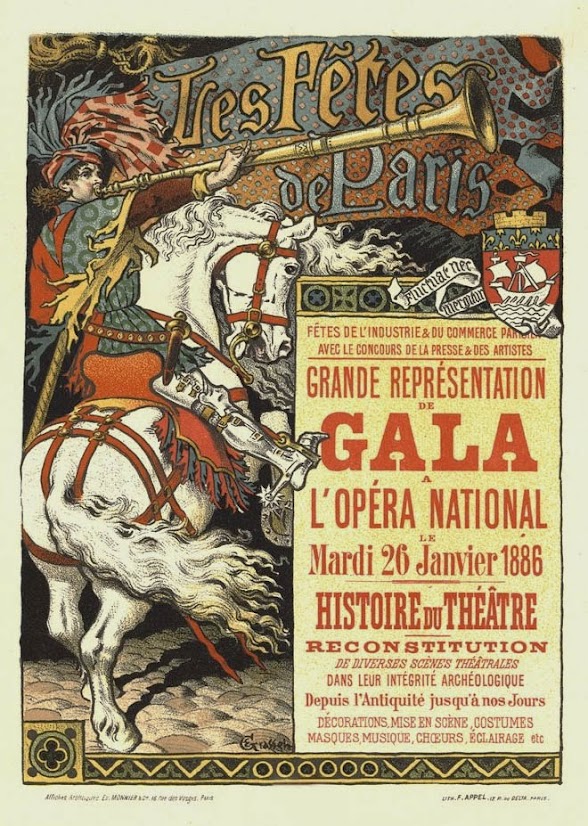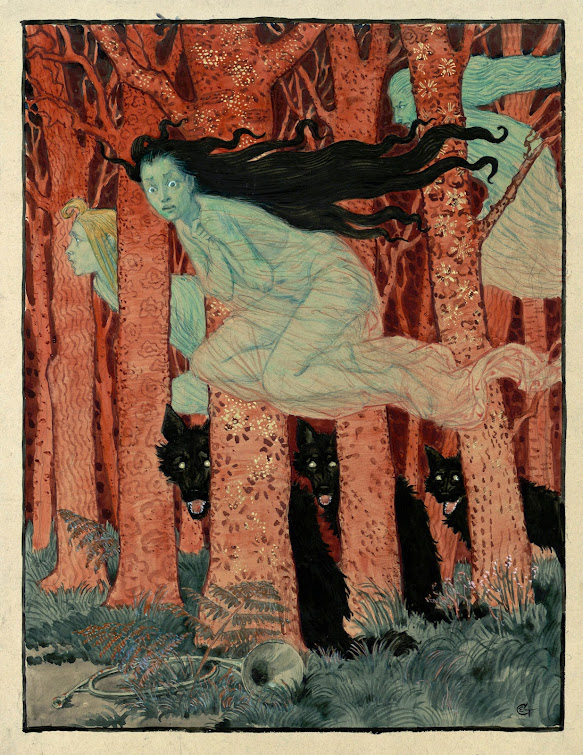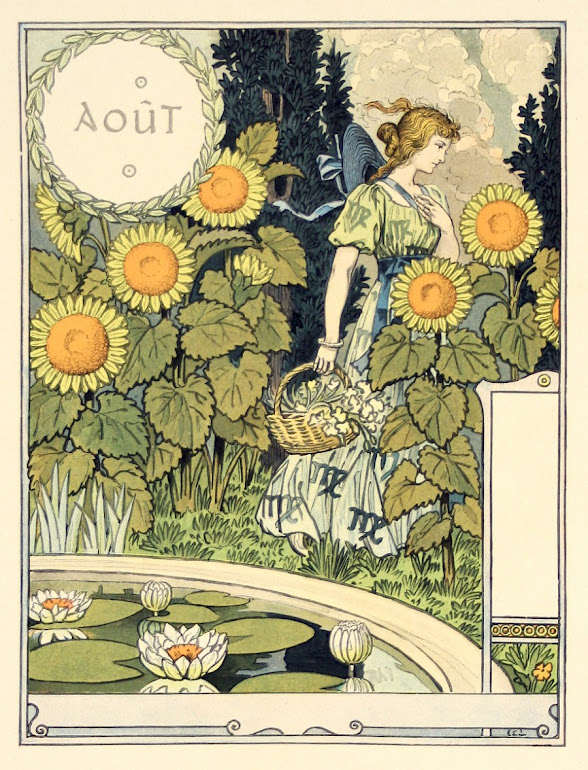Eugène Grasset (1845 – 1917) was born in Lausanne, Switzerland in 1845. He was raised in an artistic environment as the son of a cabinetmaker and sculptor who taught him at an early age how to use the chisel and the gouge. He studied drawing under Francois-Louis David Bocion (1828–1890) and in 1861 went to Zürich to study architecture. After completing his education, he visited Egypt, an experience that would later be reflected in a number of his poster designs. He became an admirer of Japanese art, which influenced some of his designs as well.
Between 1869 and 1870, Grasset worked as a painter and sculptor in Lausanne. He moved to Paris in 1871 where he designed furniture, wallpapers, fabrics, and tapestries as well as ceramics and jewellery. He created architectural elements of woodwork that were integrated into buildings. His fine art decorative pieces were crafted from ivory, gold, and other precious materials in unique combinations and his creations are considered a cornerstone of Art Nouveau motifs and patterns.
In 1877 Grasset turned to graphic design, producing income-generating products such as postcards and eventually postage stamps for both France and Switzerland. It was poster art, however, that quickly became his forte. Some of his works became part of the Maîtres de l’Affiche, including his lithograph, "Jeanne d'Arc Sarah Bernhardt".
In 1890, he designed the "Semeuse who spreads seeds of dandelion” logo used by the dictionary publishers, Éditions Larousse.
With the growing popularity of French posters in the United States, Grasset was soon contacted by several American companies. In the 1880s, he did his first American commission and more success led to his cover design for the 1892 Christmas issue of Harper’s Magazine.
1894 Grasset created "The Woolly Horse" and "The Sun of Austerlitz" for The Century Magazine to help advertise their serialised story on the life of Napoleon Bonaparte. The image proved so popular that Tiffany made it in stained glass. Grasset's work for American institutions helped to pave the way for the Art Nouveau style to dominate in American art.

Grasset taught design at the École Guérin from 1890 to 1903, at the École d’Art graphique in the rue Madame from 1903 to 1904, the Académie de la Grande Chaumière from 1904 to 1913, and at the École Estienne in Paris. Grasset had freely adapted the alphabet of Nicolas Jenson (1471) with the intention of using it to print a book on his own method for ornamental composition, inspired by the courses he gave to the Guérin school. Georges Peignot acquired Grasset's alphabet and obtained an official patent October 7, 1897 for the typeface under the name, "Grasset". He then gave Henri Parmentier, the workshop's punchcutter, the mission to engrave it. In 1896 he published a dissertation on the use of plants in designs, that featured images of designs prepared by his students.
At the Universal Exhibition of 1900 in Paris, the G. Peignot et Fils type foundry, introduced the “Grasset” typeface, an Italic design Eugène Grasset created in 1898 for use on some of his posters.
Grasset died in 1917 in Sceaux the Hauts-de-Seine department, south of Paris.
This part 1 of 2 on the works of Eugène Grasset:
 |
1885 Les Fêtes de Paris
colour lithograph poster |
 |
1887 "La danse"
Issue no. 59 of Paris illustré |
 |
1890-91 Théatre National de l'Odéon
colour lithograph poster |
 |
c1891 A La Place Clichy
colour lithograph poster 127 x 80 cm |
 |
1892 Encre L. Marquet, La Meilleure de Toutes les Encres
colour lithograph poster 121.8 x 80.8 cm
MoMA, New York |
 |
1892 Encre L. Marquet, La Meilleure de Toutes les Encres
colour lithograph poster
|
 |
c1892 Three Women and Three Wolves
colour lithograph poster |
 |
1893 Exposition des artistes-décorateurs, Londres, Grafton Gallery
colour lithograph poster |
 |
1893 Exposition Internationale de Madrid 1893-94
colour lithograph poster |
%201.jpg) |
1893 Harmony
decorative panel by Eugène Grasset and Félix Gaudin 130 x 245 cm
© RMN-Grand Palais (Musée d’Orsay) |
%202.jpg) |
1893 Harmony decorative
panel detail |
%203.jpg) |
1893 Harmony decorative
panel detail |
 |
1893 IVº Centenario del Descubrimiento de América
colour lithograph poster |
 |
1893 La Valkyrie
print after the music score cover (see below) |
 |
1893 La Valkyrie Poème et Musique de Richard Wagner
music score cover |
 |
1893 Madrid International Exposition
colour lithograph poster |
 |
Noël 1893 L'Illustration
colour lithograph poster |
%20stained%20gladd%20.jpg) |
1894 Le Printemps (Spring)
stained glass window |
 |
1894 Salon des Cent Exposition
colour lithograph and letterpress 60.6 x 41.3 cm
MoMA, New York |
 |
1894 The Acid Thrower
lithograph with hand-stencilled colours, for L'Estampe
Honolulu Museum of Art, Hawaii |
%20colour%20lithograph.jpg) |
c1894 Le Printemps (Spring)
colour lithograph |
 |
1895 The June Century, Napoleon in Egypt
colour lithograph poster 52.3 x 38.1 cm |
 |
1896 Les Petites Faunesses
colour lithograph illustration for Pierre Louÿs poem "The little Faunesses" which appeared in the first issue of the symbolist magazine "L'Image" |
.jpg) |
1896 Librairie Romantique
colour lithograph
(Plate n°42 from "les Maîtres de l'Affiche" published by Jules Chéret) |
%20The%20Cleveland%20Museum%20of%20Art,%20Ohio.jpg) |
1897 Morphine Addict
colour lithograph 56.7 x 42.5 cm (sheet)
The Cleveland Museum of Art, Ohio |
 |
| 1897 Harper's Magazine - Christmas |
 |
1897 Harper's Magazine - Christmas
visual for the above cover |
1896 Calendar:
 |
| Janvier |
 |
| Fevrier |
 |
| Mars |
 |
| Avril |
 |
| Mai |
 |
| Juin |
 |
| Juillet |
 |
| Août |
 |
| Septembre |
 |
| Octobre |
 |
| Novembre |
 |
| Décembre |
1897 Dix Estamps (Ten Prints)(eight found):
 |
| Bonne nouvelle |
 |
| Anxiété |
 |
Coquetterie
hand-coloured lithograph 56 x 55 cm |
 |
| Danger |
.jpg) |
| Extravagance |
 |
| Inquiétude |
 |
| Méditation |
 |
| Tentation |









%201.jpg)
%202.jpg)
%203.jpg)





%20stained%20gladd%20.jpg)


%20colour%20lithograph.jpg)


.jpg)
%20The%20Cleveland%20Museum%20of%20Art,%20Ohio.jpg)


















.jpg)









No comments:
Post a Comment
Note: only a member of this blog may post a comment.